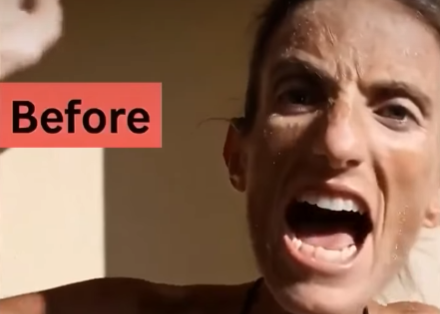
In a world where beauty is often reduced to numbers on a scale, Valeria Levitin’s life stands as both a cautionary tale and a testament to resilience. Once labeled “the world’s thinnest woman,” her story is not about sensationalism or shock value—it is about the human cost of chasing perfection, and the strength it takes to step away from the edge of destruction.
Valeria was born in Russia, where ideas about appearance were deeply entrenched in culture and family expectations. Growing up, she absorbed one message again and again: thinness equals value. It wasn’t spoken in a single sentence, but whispered through comparisons, reinforced in social norms, and echoed in the subtle but powerful judgments she encountered. By 16, she had already started dieting, not because she was unhealthy, but because she believed she needed to be smaller, slimmer, and closer to a body ideal that seemed to unlock approval.
When her family moved to the United States, Valeria carried those beliefs with her. Instead of finding relief, she walked into a culture that amplified them. The modeling industry, which she aspired to join, told her that her worth was measured in inches and pounds. Every casting call reinforced the same message: you are not thin enough. Smaller was always better, thinner was always more desirable. What began as youthful dieting quickly turned into an obsession that ruled her life.
In her early twenties, Valeria pursued modeling with determination. But paradoxically, the more she tried to fit the mold, the more it seemed to slip from her reach. Each pound she shed did not bring acceptance, but more rejection. Agencies turned her away, not for being too heavy, but for being too fragile, too extreme. Instead of standing out, she was fading. The more she conformed to the demand for thinness, the more invisible she became.
By 24, the toll was undeniable. Valeria’s weight plummeted to below 60 pounds—an alarming, life-threatening figure for any adult. Ordinary routines became monumental tasks. Climbing stairs left her breathless. Standing for too long felt exhausting. Her body, deprived of fuel, was fighting to survive. Dreams of glamour and success had been replaced with the crushing reality of physical weakness and the looming shadow of death.
What disturbed her most, however, was not just her own condition—it was the response from the outside world. She began receiving letters and messages from teenage girls across the globe. They weren’t worried about her health; instead, they admired her skeletal figure. Some asked for “tips” on how to achieve the same look. Others confessed they saw her as proof that they too could shrink themselves into an ideal. To Valeria, it was devastating. She realized that her image, stripped of its pain, had been twisted into aspiration.
That moment became a turning point. Instead of disappearing quietly, Valeria chose to speak out. “I’m not here to teach girls how to disappear,” she said firmly in interviews. She began sharing her story not as a badge of endurance, but as a warning. She wanted people to see past the photographs and headlines and understand the suffering, isolation, and damage that came with her condition.
Her decision to speak publicly transformed her into a reluctant advocate. She opened up about the emotional roots of eating disorders—the insecurity, the pressure, the relentless pursuit of an unattainable image. She urged young people to value health and authenticity over conformity. And she tried, as best as she could, to dismantle the toxic myth that shrinking one’s body was a path to love, respect, or happiness.
Valeria’s story resonated worldwide because it captured something many people recognize but rarely voice: the destructive power of a culture that prizes appearances over humanity. In her frail frame, people saw the extreme conclusion of society’s obsession with thinness. She became both a symbol of warning and a mirror reflecting the consequences of impossible expectations.
But her journey was also about recovery—not just physical, but emotional. Valeria began to focus on rebuilding her strength, not simply by eating more, but by rethinking what it meant to live. She emphasized that health is not about deprivation, but nourishment. She redefined beauty not as fragility, but as resilience. And most importantly, she spoke about the courage it takes to step away from self-destruction and choose life instead.
Her battle was not easy. Eating disorders are not simply habits; they are deeply rooted struggles tied to identity and worth. Recovery is long, uncertain, and often incomplete. But Valeria’s willingness to be visible, raw, and unglamorous in sharing her truth gave hope to those who might otherwise stay silent.
She often reminded audiences that images can lie. The photographs that once made her famous showed only angles and shadows, not the exhaustion, pain, and fear behind them. True beauty, she argued, is not about the bones that protrude or the digits on a scale. It is about authenticity, about embracing the body as a vessel for life, not as an enemy to be conquered.
Valeria’s life underscores a critical lesson: the pursuit of perfection can erase the very things that make us human. Health, joy, connection, and individuality matter more than any dress size. Her voice continues to echo in conversations about eating disorders, reminding us that admiration without understanding can be deadly.
In the end, her journey is not defined by being “the thinnest woman.” That was never her goal. Her legacy is in the choice she made when faced with the reality of her condition: she chose to stop shrinking, and instead to expand—her voice, her message, her compassion.
Her story is a call to action. It challenges industries that glorify unattainable ideals. It urges parents and educators to pay attention to the pressures their children face. It asks all of us to consider the cost of measuring worth in pounds and inches.
Valeria Levitin’s life may have begun in pursuit of beauty, but it grew into something far more meaningful. It became a fight for truth, for survival, and for the recognition that every human being has value beyond appearance. Her message is simple but profound: we are not here to disappear. We are here to live, to be strong, and to be real.

